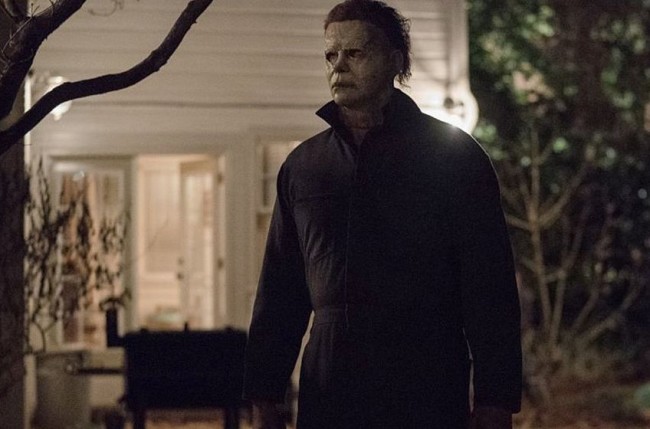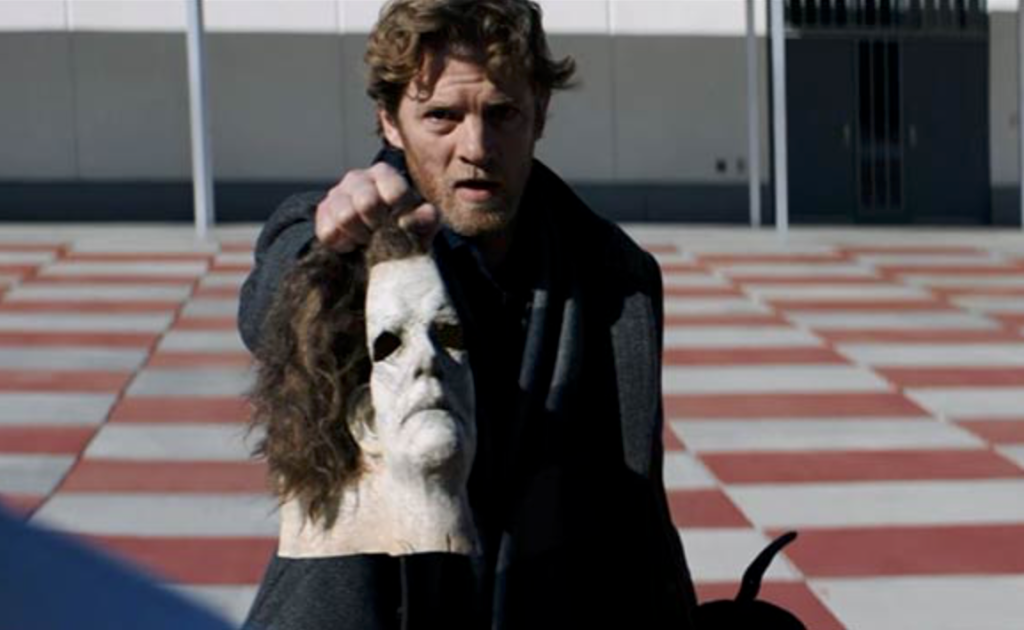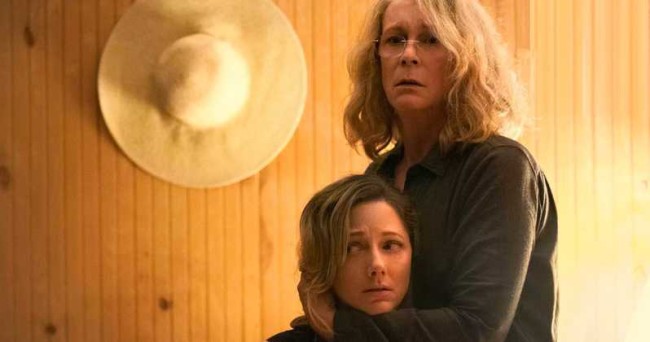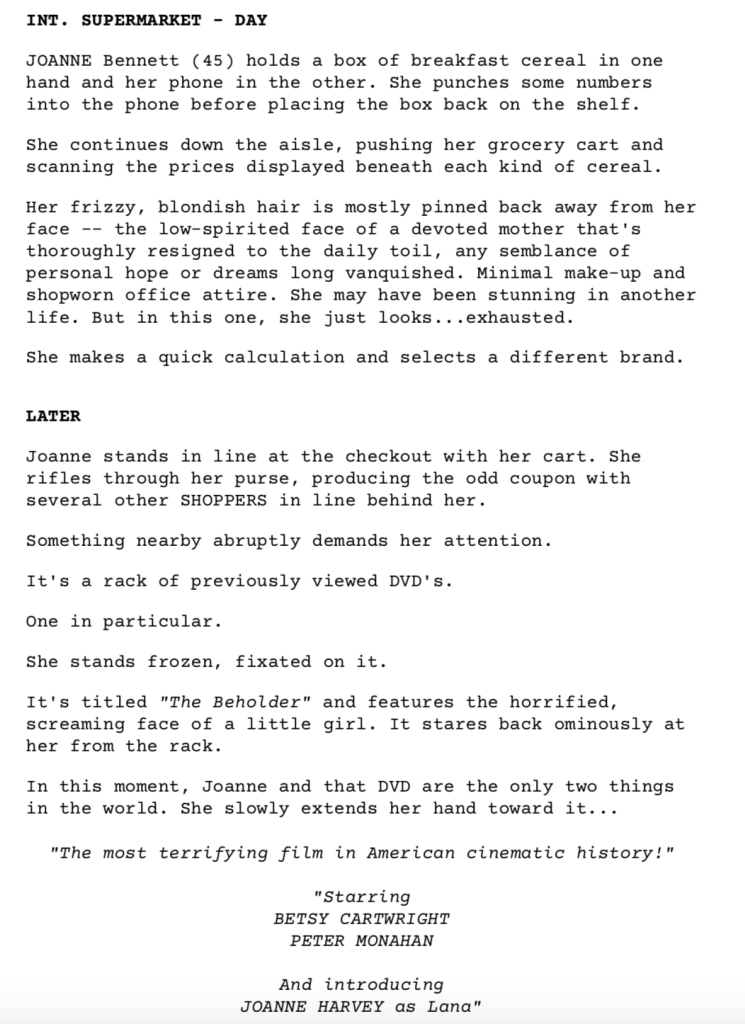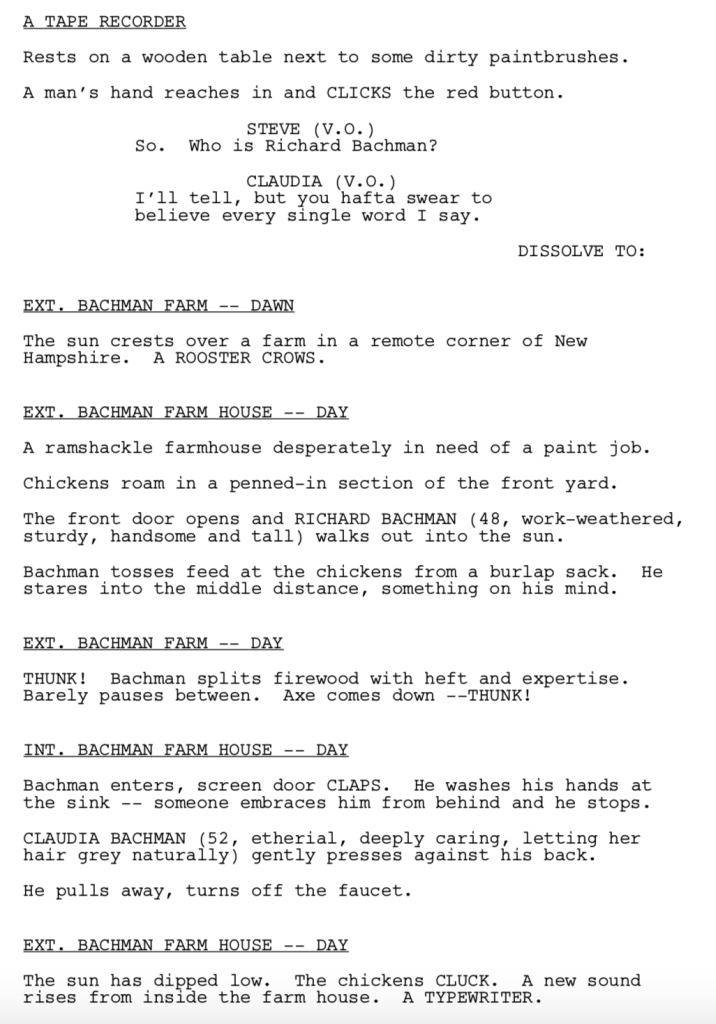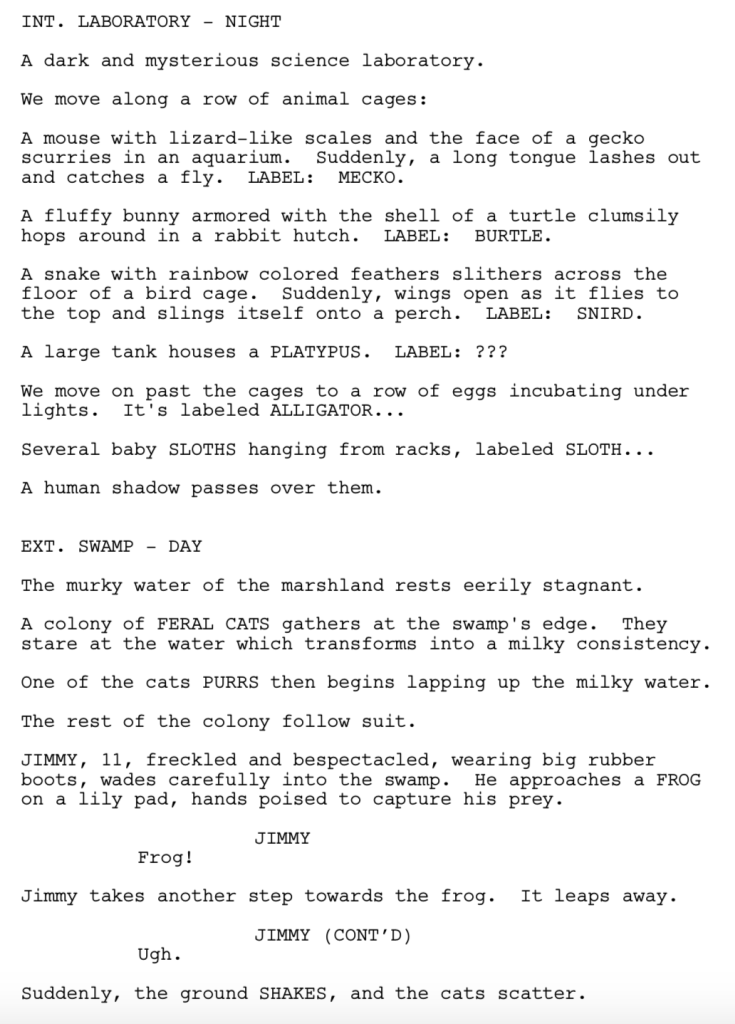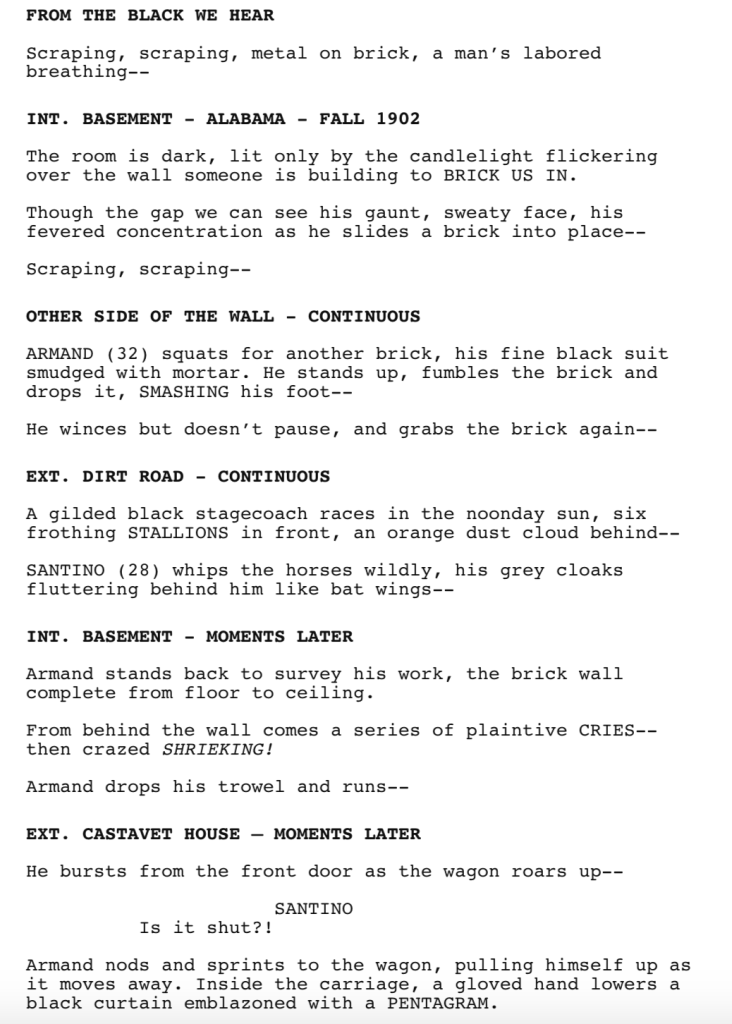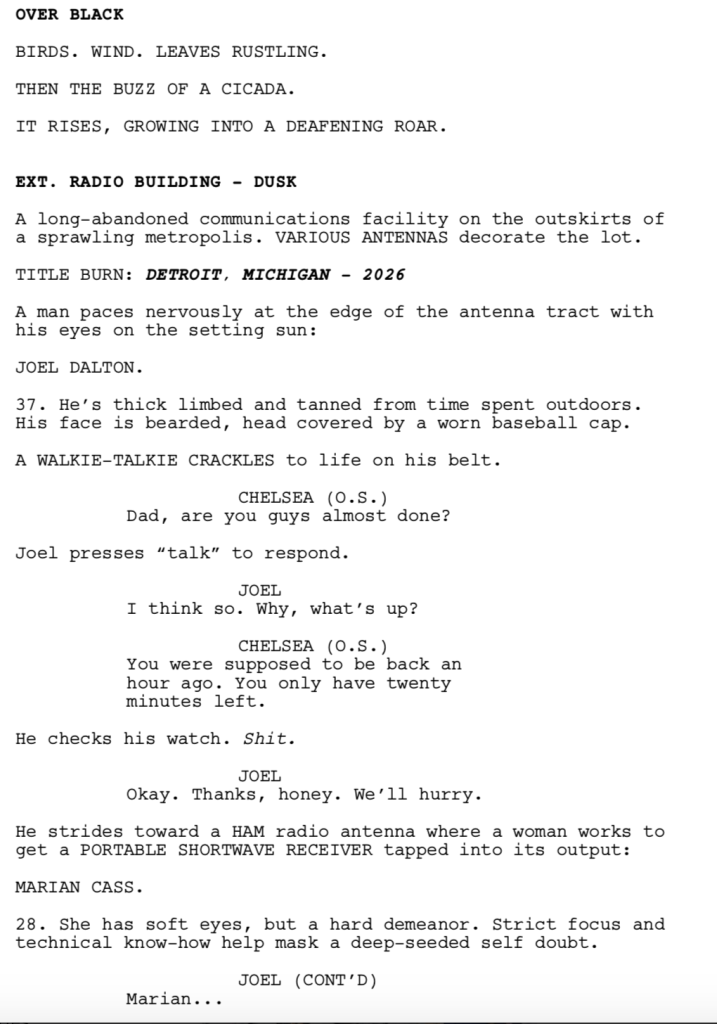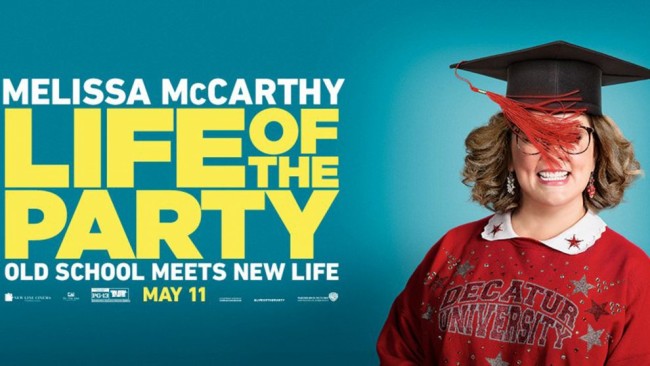Genre: Horror
Premise: (from IMDB) Laurie Strode comes to her final confrontation with Michael Myers, the masked figure who has haunted her since she narrowly escaped his killing spree on Halloween night four decades ago.
About: The chameleon’esque David Gordon Green (Pineapple Express) won this sequel by pitching his unique take on the franchise: “What if none of the sequels happened?” Funny enough, he didn’t yet know if he could get Jamie Lee Curtis for the part. Before landing her, he considered doing a Force Awakens soft-reboot approach. But Curtis signed on within 24 hours of reading the script, and a buzzy Halloween project was on its way.
Writers: David Gordon Green, Danny McBride, Jeff Fradley (characters by John Carpenter and Debra Hill)
Details: 105 minutes
The opening scene of Halloween (2018) does something so drastically wrong, I was convinced the movie was doomed. I’ll get to that mistake in a second. But first, it’s time to give credit to this reboot. There is nothing cooler in Hollywood than a surprise hit – when a film does better than everyone expected (77 million dollar opening weekend!). It reminds us not only what’s possible, but of why we became drawn to this industry in the first place. To chase the high of one day writing a movie that everybody goes to see.
For those who haven’t seen the film, the original “Final Girl,” Laurie Strode, is all grown up. The 50+ grandma lives in a house/bunker of sorts, where she’s spent 40 years preparing in case the man who attacked her and killed 5 people, Michael Myers, escapes the nearby psychiatric ward. Her mother, Karen, has given up on her, while her granddaughter, Allyson, hopes to bring her back into the family fold.
Meanwhile, a couple of British podcasters are doing a podcast on the Michael Myers killing, which introduces the plot point that Michael Myers is being transferred to a prison for the end of his days. Since it wouldn’t be a movie unless that prison bus crashed, the prison bus crashes, and Laurie goes into psycho prep mode, getting her family to her house so they can wait out Michael’s arrival. After killing a half-dozen poor souls, Michael indeed shows up, and the big battle is on.
So let’s talk about that opening scene, shall we?
In it, our podcasters, Aaron and Dana, arrive at the psychiatric ward to meet the subject of their podcast, Michael Myers. They’re joined by Michael’s doctor, Dr. Sartain, and head out to a concrete yard where all the patients are tethered to sectioned-off squares. The giant lumbering Michael is in the middle of the yard, his back to us.
An eager Aaron gets right up to the edge of Michael’s allotted square and starts blabbering away. When Michael doesn’t turn around, Aaron says he “brought something” for him. He then takes out Michael’s infamous mask. As he does, the other patients begin to unravel. They start mumbling, then pacing, then grumbling, then yelping, then yelling, eventually becoming a yard full of riled up chimpanzees. Michael, however, never turns around. As this is happening, Dana looks back at Michael’s doctor, who gives her, I kid you not, an “It’s okay,” nod, allowing Aaron to continue. The scene eventually cuts to the opening titles.
On the surface, this scene is great. I loved that they did the opposite of what was expected, which is to present Michael in a small secured room, a la Hannibal Lecter. To take us outside in broad daylight, especially with all the patients constrained to their own little sections, was perfect. It started off great.
And then it fell apart.
Why are the patients jumping around, hooting and screaming like chimpanzees? They have no idea what this mask is. They don’t know what this presentation represents. But the worst part is when Dana looks back to Dr. Sartain as if to say, “Is this okay?” and Dr. Sartain nods a, “Yeah, this is fine. Let’s see what happens.”
Holdupholdupholdup.
Let me get this straight. You have a psychopathic killer. He’s being presented with the symbol of his killings. You have a bunch of people screaming at the top of their lungs. And you just… allow it to happen???
A certified doctor whose only job is to ensure the well-being of his patients is allowing something to be shown that may reignite his most dangerous patient? What kind of nonsense logic is this?
The ONLY reason any of these things are happening is because the writer wants them to, not because they would. You can never violate that contract with your audience. Once you do, consciously or subconsciously, the audience knows something is wrong. Their suspension of disbelief has either broken or cracked. I mean seriously. What doctor in their right mind is going to allow this to happen? None. Not a single one.
And that’s too bad. Because the framework for this scene is strong. But you need to hold yourself to higher standards. By being truthful, you could’ve made this scene great.
Sure enough, this foreshadowed similar problematic scenes. Laurie Strode has been presented as this backwoods badass who’s been training for battle for 40 years. Yet the first moment she encounters Michael, who she learns is somewhere outside her house, she inches her way up to the windowed door and stands there like a clueless idiot. Sure enough, Michael’s arm shoots through the window, grabs her, and starts bashing her against the door.
Why is this bad screenwriting? Because, clearly, the writer and director wanted an arm-grab-through-the-window moment. They wanted it so bad that they betrayed everything they set up in the character. They introduced her as the world’s most prepared woman, only to turn her into a bumbling moron at the FIRST CHANCE she has to take down Michael. And for what? A cool 30-second struggle? You betray your character for that?? Come on.
You might think with these scathing critiques that I disliked Halloween. You’d be wrong! I actually thought it was pretty good. Namely because of what they did with Laurie Strode. This was a surprisingly deep character. Instead of slapping a “crazy” label on Laurie then blasting us with a bunch of silly Halloween kills, this movie asks what would’ve happened to someone like this, the lone survivor of a tabloid-grabbing murder spree. And they dig deep into Laurie’s psychology, specifically her relationship with her daughter and granddaughter. I loved that they didn’t shy away from that. And it’s why moments like the door scene bothered me so much. Because they put chinks in what was a great character, especially for a 50+ year old woman. Roles with this kind of depth are rare to find for this demo.
And there were quite a few scary moments. One of my favorites was when a father and son drove up on the prison bus crash in the dead of a foggy night. With their headlights illuminating the wandering bodies of the patients on the road, you just knew Michael was out there lurking. More importantly, it went against the traditional horror setup, which is to place your characters in small spaces where there isn’t any room to maneuver. Here, it was wide open (just like the opening scene) and still terrifying as hell.
The next good scare (spoiler!!) occurred on the opposite end of the spectrum. A newly deranged Dr. Sartain places a blacked-out Michael Myers in the back seat of the cop car with Allyson. We go from the most wide-open space to the most contained. And props to the writers for drawing this moment out. Again, scenes like this are never about the struggle once the character wakes up. They’re about milking the moments UNTIL the character wakes up. You sit on that. You make the audience dread it. And dread it we do. Is there anything more terrifying than the possibility of Michael Myers waking up next you in a room you can’t escape from?
Unfortunately, Halloween feels like a script that needed 2 to 3 more drafts. The story is designed to have Laurie and Michael duke it out at her house in the final act. And had you told me that was the selling point, I’d have been excited. But everything about the climax is clumsy. For someone who’s been preparing 40 years for this, Laurie doesn’t seem to have much of a plan outside of “turn the backyard lights on.”
An easy way to tell they were rushing was the featured kitchen contraption – an island that slid out of the way revealing a secret trap door to the basement. They must’ve showed that thing opening and closing a dozen times in the last 20 minutes. It was way overused. Rewrites allow you to consolidate and streamline hiccups like that.
All in all, Halloween was a “liked it, didn’t love it” film. It had its moments. Its heart was in the right place. But you left feeling like they dropped the pumpkin. Too bad. Maybe the next one will be better.
[ ] What the hell did I just read?
[ ] wasn’t for me
[x] worth the price of admission
[ ] impressive
[ ] genius
What I learned: Create actions that oppose the setting. This always works. The idea is you have a setting, then you make a character perform an action that normally wouldn’t happen in that setting. For example, Allyson’s family is having dinner at a restaurant. Restaurants are supposed to be fun happy places where you eat and enjoy conversation. However, Laurie shows up unexpectedly, sits down, starts talking, then, out of nowhere, bursts into tears. The family becomes incredibly uncomfortable, and, boom, now we have a scene. It’s a subtle trick, this “contrast in place and action.” But it tends to work well. To understand the power of this device, imagine the exact same scene occurring, but back at the family home. It’s not nearly as interesting, is it?
Holy Slutty Halloween Costume! There were a TON of Halloween Amateur Offerings entries. If I’d known there were going to be this many, I would have created a more elaborate competition. Alas, it’s a cut-throat business out there. As per the rules of the game, only five of you made it in. It wasn’t easy pickings. I tried to cover multiple sub-genres so not everything felt the same. Unfortunately, this meant that some strong contenders didn’t get in. Who knows, maybe I’ll throw a few of these into a future competition.
Since I have to stay out of the comments (can’t be persuaded by the reactions), I’ll be checking out the latest Halloween movie this weekend, then review it on Monday. There’s a lesson in “Halloween” for aspiring screenwriters, by the way. One of the things that will happen when you break in, is that you’ll meet with a bunch of people in town. Some of these people will own famous old properties. If you can come in and pitch a fresh take on one of these properties, they may pay you to write a draft. David Gordon Green and Danny McBride came up with this idea of, “What if we pretended that none of the Halloween sequels existed and made this a straight sequel to the original Halloween?” The studio liked that take and allowed them to make the movie. So when that opportunity comes for you, be ready! Have a take formed and a pitch prepared. Even if they had no intention of bringing it up themselves. “Hey, I know you guys own Nightmare on Elm Street. I have an idea for a sequel.” What are they going to say? “We don’t want to hear it?” Of course they do. So be ready!
If you haven’t trick or treated at the Amateur Offerings house before, here’s how the game is played. Read as much of each screenplay as you can, then vote for your favorite script in the Comments Section. Voting closes on Sunday night, 11:59pm Pacific Time. Winner gets a review next Friday. — If you’d like to submit your own script to compete in a future Amateur Offerings, send a PDF of your script to carsonreeves3@gmail.com with the title, genre, logline, and why you think your script should get a shot.
Oh, and one last thing. Move over Trajent Future. Out of the way Larry the Lyft Driver. Sayonara Orbitals. I’m pretty sure “Slothigator” just became the newest Scriptshadow Meme.
Title: THE EVIL EYE
Genre: Horror
Logline: Something terrifying awakens within a middle-aged mom when she finally decides to watch the now-classic horror film that she starred in as a child.
Why You Should Read: To this day, rumors persist of a supposed “curse” attached to the modern classic horror film, “The Beholder”. The movie enjoyed both critical acclaim and box office success upon its premiere in October of 1983, and it is still commonly hailed as being among the most terrifying films in the history of American cinema.
But the film’s production was plagued by an endless string of on-set accidents, misfortune and tragedy. And the “curse” only seemed to intensify in the months and years following the movie’s release with the mysterious and untimely deaths of many of the cast and crew, including director John Friedman and lead actors, Betsy Cartwright and Peter Monahan.
Only nine years old at the time, the film’s youngest star, Joanne Harvey, seemed poised to take the movie industry by storm. But in the wake of an auto accident that claimed the lives of her parents after the premiere of “The Beholder”, Joanne Harvey disappeared from Hollywood, never to be heard from again.
Title: The Bachman Books
Genre: Horror/Biopic
Logline: A freelance journalist becomes entangled in one of the greatest literary coverups of the 20th century. Based on a true lie.
Why You Should Read: This is based on the true story of the journalist who discovered that Stephen King was writing under the pseudonym Richard Bachman – and I should know, because that journalist is me, Steven P. Brown. – Consider this a sidebar to the real story, which involved a simple trip to the library of congress, where I pulled the copyrights to the Bachman books. Boring! What if, in my pursuit of the truth, I got roped into a terrifying game of cat and mouse with a man claiming to be the real Richard Bachman? You mention that a surefire way to break in as a screenwriter is to write a biopic, so I’ve put my own twist on it with a horror/thriller that I hope would make Mr. King himself proud.
Title: Slothigator
Genre: Horror Comedy
Logline: A dysfunctional family must work together when a giant, man-eating sloth/alligator hybrid creature wreaks havoc at their Louisiana amusement park.
Why You Should Read: Despite it’s admittedly bonkers premise, Slothigator offers a healthy share of sentimental family drama to accompany its creature-feature gore fest. By providing the audience with a well rounded family, we believe Slothigator goes beyond its genre and would be able to connect with the audience at a more personal level. After months of sleepless, research filled nights, we can confirm that the science presented in this script is 100% accurate.
Title: In the Basement
Genre: Family Horror
Logline: When some neighborhood kids go trespassing in an abandoned house, they accidentally open the door to Hell, and have to battle a crazed demon horde to close it back before the Devil escapes.
Why You Should Read: Poltergeist is easily one the best, scariest movies ever made, yet somehow it’s for the entire family (well, minus the face-ripping scene). Recently, Amblin has returned to family horror with the House With a Clock in Its Walls—according to Eli Roth, Spielberg told him to make it as scary as possible, that “kids love good scares.” I agree, but every Halloween I’m reminded there aren’t really that many quality horror movies for kids. ‘In the Basement’ takes up the challenge, and is intended to scare the shit out of little kids while keeping things fun and exciting (it’s “fun scary,” as I would tell my kids). The script has gotten some festival love, and was a finalist at Crimson Screen and a Night of Horrors. I hope you enjoy, particularly if you’re under the age of 15.
Title: BLACK LIGHT
Genre: Monster / Action
Logline: In a world overrun by nocturnal monsters only seen under black light, four survivors are forced to travel overnight through a post-apocalyptic Detroit in order to reach a boat that will take them to safety.
Why You Should Read: Not only is it a character based horror film with a hook, but it’s also got some kick ass, Carson-inspired G.S.U. going on. Four people who need to get from one place to another — only five miles — but they have to do it overnight in a world where the last thing you’d ever want to do is go out past dark. Basically, I set out to write something big and fun with cool / scary set pieces and limited locations to keep the budget managable. Think ALIENS meets FURY ROAD with a touch of TREMORS sprinkled in for good taste. As far as I’m concerned, if it turned out even remotely similar to any of those three films, then it would have to be worth some kind of consideration. And yes, I understand that’s a big “if.” Either way, thanks for taking the time and happy Halloween.
“Like it Didn’t Love It” refers to an old industry response to the glut of screenplays shoved into the system, and the many people who were required to read them. “What did you think of the script?” a co-worker or boss would ask the reader. “Liked it, didn’t love it.” It was a nice way of saying, “not bad.” Unfortunately, “not bad” doesn’t get a script anywhere. And if we’re being honest, it essentially labels the script dead in the eyes of the company that read it.
As someone who’s read north of 7500 screenplays, I know this experience all too well. The majority of the scripts I read are not good. A select few are very good. Between those extremes is a frustrating selection of screenplays (probably around 15%) that are pleasant reading experiences, but nothing more. I may even enjoy them while reading them. But if literally any distraction comes up, I choose that distraction over the script. These are “Like it Didn’t Love It” scripts. And it’s time to get into how to avoid writing one.
“Like It Didn’t Love It” scripts fall into five categories. The “Technically Perfect” script. The “Safe Concept.” The “Lacks Passion” script. The “Third Draft.” And the “Not Up To the Challenge” screenplay. Let’s take a look at each of these in detail.
The Technically Perfect Script – The technically perfect script is often written by screenplay-book junkies. They know everything about screenwriting, more than me even. They are slaves to the “rules” of screenwriting, often strangling the creativity from their story in favor of meeting plot beats on the right pages. If a writer’s been at this for a while, they can make a “Technically Perfect” script pretty good. But the ceiling for scripts this devoid of creativity is only so high, which is why even the best ones can only hope to achieve “Like it Didn’t Love it” status. When it comes to recent films, Skyscraper and Life of the Party are “Technically Perfect” scripts.
The Safe Concept – The safe concept has some crossover with The Technically Perfect Script because when you choose a safe generic concept, you will usually execute it in a safe generic way. But the main difference between these two is that the “safe concept” is so vanilla that, even under the best circumstances, the script can only be taken so far. With that said, the word “safe” is used for a reason. It’s “safe” because it works. And that means these scripts, if written well, are mildly enjoyable in the same way that orange chicken from Panda Express is mildly enjoyable. Unfortunately, the reaction to both afterwards is the same. “Why did I put myself through that?” Examples include “I Feel Pretty,” “Truth or Dare,” and “The Commuter.”
The I Clearly Am Not Passionate About This Script Script – These scripts often come about by writers who are sick of their low-concept dramas (or any non-traditional script) being ignored by the industry and finally give in to the notion that you need to write a marketable screenplay to get noticed. They hop on the latest trend (say, Girl With A Gun), writing their version of it, only to get rebuked by the industry once again, reinforcing their belief that their initial approach was the right way to go. — Look, you have to love what you write for it to be any good. Even great screenwriters struggle to make stories work that they’re uninterested in. It’s hard to find produced examples of this, since virtually any lifeless movie could be an example. But yeah, if you’re not getting paid, think long and hard about writing something you have no passion for.
Third Draft Scripts – Third draft scripts are scripts where you can see the promise of the story but the writer hasn’t done the hard work yet. Now, obviously, every writer defines drafts differently. For some, it’s an extensive process that requires tons of outlining and character work each time out. These writers can write a good script in 4-5 drafts. For others, they write quickly, and can belt out a draft in a week. For them, writing a good script takes 10-15 drafts. So “third draft” is more of a symbolic moniker that represents a writer who’s written a decent script that could’ve been a lot better had they written a few more drafts. The example I always give of this is The Sixth Sense. In the third draft of The Sixth Sense, M. Night’s story was about a kid who drew pictures of the future. By the 10th draft, it was about a kid who saw dead people.
Not Up to the Challenge Scripts – “Not Up to the Challenge Scripts” are actually scripts that have the potential to be “Love It” scripts, but the writer’s skill level isn’t yet high enough to stick the landing. Or another way to look at it is that their eyes are bigger than their mouths. These scripts often cover weightier material, a biopic with Oscar in its crosshairs (White Boy Rick) or a time-spanning period piece (Gangs of New York), or really ambitious rule-breaking type projects, a Pulp Fiction or an I, Tonya. You need to have been at this for awhile to pull one of these scripts off. In the meantime, you will be praised for your script’s “flashes of brilliance,” but condemned for its inability to “bring it all together.” While I think it’s important that every writer push their limits, it’s also important to know your limitations. You’re not going to write Pulp Fiction as a beginner. You’re just not.
Now that you know what scripts are most likely to turn into “Like it, Didn’t Love It” scripts, what can you do to write these elusive “Love It” screenplays? There’s no definitive answer to this question. But I will say this. The scripts most likely to make readers fall in love with them are scripts that contain a high level of emotional resonance. A heavy focus is placed on the interplay between character and theme. This is the best combination to emotionally affect the reader. And once you make a reader FEEL something, the chances of them falling in love with your script rise dramatically.
A perfect example of this is Eighth Grade, the film I reviewed on Monday. That was not the most amazing script. It didn’t have much of a plot. But Bo Burnham so effectively explored the theme of loneliness and the desire to connect through this imperfect but impossible not-to-like 13 year old girl, that it didn’t matter. We FELT something. And when you feel something, you don’t care about inciting incidents and first-act turns and whether the “fun and games” section was long enough. Emotion is the great-eraser of logical analysis. Which is why, if you’re trying to become a better screenwriter, the primary area you should be studying is character development. Understanding the psychology of people, then combining that with the technical know-how of establishing flaws in characters (in “Eighth Grade,” it’s that Kayla is too quiet) is the first step towards mastering this skill.
With that said, there are several additional things you can offer that increase the chances of writing a “Love It” script. Number one, take chances in your story. I always say that it isn’t the rules you follow that make your script great. It’s the rules you break. Anybody watch “Swiss Army Man” and think, “Way too many safe choices here?” Two, as I mentioned above, try to write something you’re passionate about. The more passionate you are about something, the more effort you’re going to put into it, and that’s going to come across on the page. Three, if you have a strong voice, like Zoe McCarthy from Tuesday’s review, write a script that takes advantage of that voice. And four, write a “tweener” script. The advantage of tweener scripts (scripts that combine two different genres) is that you’re more likely to write something original. But, of course, everything with a big upside has an equally steep downside. Get these wrong and people ask you, “I couldn’t tell if this was an [x] or [y] film!” A good tweener film is Get Out (horror and social commentary). A bad one is Tag (was it a comedy or a drama?).
I’m sure some of you are asking, “Well, Carson. If some of these Like it Didn’t Love It scripts are getting made, then how bad can it be to write one? Look, Hollywood has too many slots to fill not to make some Like it Didn’t Love It movies. The reality is, however, Hollywood doesn’t look to you, the unknown screenwriter, to provide them with this material. They can come up with average material on their own. As an unknown writer, you must STAND OUT in order to get your scripts through the system. Which is why you should be aiming to write “Love It” material.
I want to finish this off with one final piece of advice. I am not advocating that you write your passion project about the irrigation issues that the native peoples of 1781 New Zealand faced. Every script idea should be seen through the lens of “Will anybody pay to see this?” That’s the caveat to all of this – the one rule you have to follow. Nobody’s going to make your movie if there isn’t an audience for it. Conversely, the bigger the audience potential your idea has, the more lenient the analysis of your script will be.
Genre: Contained Thriller
Premise: When a malicious cyber attack against U.S. Space Command forces the President-Elect and the outgoing President into the Situation Room hours before the Inauguration ceremony, the rival Presidents and their National Security teams work with and against each other to determine who is responsible for the attack and how to respond before it’s too late.
About: Writer Patrick McConville originally worked as an assistant at CAA in TV talent. He would go on to work as an executive for director Marcus Nispel. He’s been toiling away at screenwriting ever since, Inauguration Day being the culmination of a six-year journey from his last well-received script, Tom Sawyer’s Island. Inauguration Day finished with 8 votes on last year’s Hit List, a yearly list of the best spec scripts.
Writer: Patrick McConville
Details: 116 pages
It sucks that these high-concept specs have been relegated to low-vote status on the Hit List (not even making the Black List anymore). There was a time where a big concept like this would’ve garnered a million dollar sale. However, when you look closer, you realize this isn’t your average high concept. It’s actually a genius update. McConville takes a giant idea and relegates it to a single location, pasting what used to be a Dean Devlin/Roland Emmerich special into the Contained Thriller genre. That’s how you position high concept in today’s market. Let’s see how the script turned out.
46 year old President Juliet Garcia is spending her last day in the Oval Office with her children, preparing to leave behind what many consider to be an embarrassing tenure, highlighted by a massive terrorist attack in Wrigleyville, Chicago, during a Cubs game. Not only did the terrorists kill over 2000 people, they were able to escape to Syria, where Russia has helped shield them from American justice.
Meanwhile, 57 year old president-elect Owen Everett is getting ready for his inauguration. Ironically, it was Everett, the former Speaker of the House, who prevented Garcia from making an executive order to invade Syria to grab the terrorists. The non-confrontational Everett not only won that game, but won the match since the event pegged Garcia as a president who couldn’t get the job done.
In short, there’s history between these two.
An hour and a half before Everett’s sworn in, a U.S. satellite goes down. We quickly learn this satellite is part of an array of satellites that run the U.S.’s GPS system. When a second satellite goes black, our presidents realize this is a matter of national security, and head to the Situation Room to figure out what’s going on. The operating theory is that Russia infected the U.S. satellite array with a virus, taking them down one by one, so that our military GPS will be eliminated. The question then becomes, what do they plan to do next?
Garcia sees this as an opportunity to make up for the Wrigleyville disaster, advocating for a pre-emptive military strike on the Russians. Everett, meanwhile, wants to take some time and figure out what’s going on here. The two are buttressed by their teams, who stand loyally in each contender’s corner, and a 90 minute battle of wills ensues that will not only determine the fate of this problem, but the fate of the world.
I’m not sure I was ready for what McConville wanted to do here.
I was expecting (and wanted) the beach read version of this premise. Instead I got what might happen if Walter Isaacson wrote a screenplay. There was a TON of information to get through. A lot of characters. A lot of policy and politics and below-the-water chunks of an iceberg. This was researched and then re-researched so that everybody is representative of their real-life titles. Some hardcore burden of investment is required to even BEGIN to understand what’s going on. And that was easily my biggest issue with the script.
Which sucks because this is a great idea. Put the president and the president-elect in a room together where they need to solve an impending catastrophe. It’s one of those, “Why didn’t I think of that?” ideas. But, oh boy, do we have to go through a lot to get to the fun.
For starters, we have a ton of voice over from news anchors giving us backstory on the two presidents. We’re then meeting an endless cast of characters. There’s all of Garcia’s staff and then there’s all of Everett’s staff. I don’t think enough writers realize that if you cram 8-10 character introductions – especially big important people like the characters in this script – into a 5 page section, you’ll be lucky if the reader remembers three of those characters.
I don’t know why it’s so hard for writers to understand that readers aren’t computers. We don’t automatically remember everything you throw at us. Often times it’s the opposite. We’re being given a ton of information early on, and we have to parse out what we think is important and unimportant. Inevitably we turn out to be wrong, which means lots of characters and story points become casualties, never to be entirely remembered or understood.
This is why I always say to screenwriters: Only introduce characters if you have to. If someone’s not going to play that big of a part in the story, see if you can get rid of them or combine them with another character. You’re not only consolidating your story, but you’re making it easier for your reader to keep up.
It’s not surprising that this factors into my next biggest complaint in the script – which is that I wanted this to be Garcia vs. Everett. I wanted them arguing. I wanted them having to figure things out together. When there were problems, I wanted the problems to be between them. Instead, there’s ALLLLL these characters shouldering the weight of the story, with Garcia and Everett popping in whenever they’re needed.
It’s only once we get past the mid-point that our presidents really take center stage and dominate the conversation. Not surprisingly, that’s when the script really picked up. It’s crazy. I was convinced this was a “wasn’t for me” through the first 70 pages. But once it became Garcia vs. Everett, I was pulled back in. Which begs the question, why wasn’t it always about them? The answer is probably that McConville wanted to keep this authentic. If this situation were to really go down, all these extra players he included would probably be there. And I can respect that. I preach about authenticity all the time. I just think he went a bit overboard. In screenwriting, you want to avoid anything that takes precedence over the coolest thing about your script. And the coolest thing about this script was always Garcia vs. Everett.
To McConville’s credit, the script came together in the end. While at first I was ho-hum about a GPS terror plot, I loved how the story evolved into this rising battle with Russia, led by two competing philosophies – Garcia representing the shoot-first-ask-questions-later side, and Everett representing the let’s-think-this-through side, even if that got him labeled a “pussy” by everyone in the room.
I only wish there was more of that president-vs-president stuff in the beginning of the script. That’s the sandbox that sold me so that’s the sandbox I wanted to play in!
[ ] What the hell did I just read?
[x] wasn’t for me
[ ] worth the read
[ ] impressive
[ ] genius
What I learned: Unless you’re writing a script that contains a handful of characters, you can probably benefit from getting rid of 20% of the characters in your screenplay. Remember that less characters means it’s easier for the reader to keep up and you get to spend more time developing the characters that matter.
What I learned 2: Dressed-Up Contained Thrillers. Everyone is trying to come up with contained thriller concepts because they’re cheap to make and easy to market. But there are two levels of Contained Thrillers. The first is the standard type. This is what most people go with because it costs nothing. I’m talking about stories that take place in a basement, a diner, a tunnel, a coffin, a house. Inauguration Day is a level up from that, what’s known as a “dressed up” contained thriller. These actually require a set to be built. Yes, these films will cost more money than your standard contained thrillers, but they’ll feel bigger, allowing them to compete with much bigger films. If you’re trying to make a movie yourself, go with a standard contained thriller. If you’re trying to sell a script, a dressed-up contained thriller is a better option.
Genre: Comedy
Premise: A morally bankrupt woman kidnaps her left-at-the-alter brother to the Amalfi Coast, posing as his wife to secure the $250,000 Honeymoon Prize he won.
About: This one finished in the middle of the pack on the 2016 Black List. It was written by Zoe McCarthy, who I’ve reviewed before. Her script, “Cut and Run,” followed a female urologist and a retired hooker as they took down a notorious sex trafficker in Miami. She also has a project in development called “Bitches on a Boat,” which covers similar territory to today’s script. It’s about a female sports agent who’s dumped by her fiance minutes after she embarks on a cruise ship bachelorette party. McCarthy is still looking for that lucrative “written by” credit, a process that shouldn’t take much longer if she keeps displaying this level of talent.
Writer: Zoe McCarthy
Details: 110 pages
I think I’ve reviewed every script rated higher than this one on the 2016 Black List. So what’s taken me so long to read Hart You? To be honest, the logline made me feel icky. I was skeptical that an incest-joke could work for 110 pages. I wasn’t even sure the joke could work for a scene. Do I really want to read an entire script where a brother and sister have to pretend to have the hots for one another? Is that funny? Let’s find out.
32 year old Naomi is what you might call a lost cause. She has no significant other. No job. She spends most of her days getting high and stalking her hot musician ex-boyfriend on Instagram. Her younger brother by two years, Brandon, conversely, has a picture-perfect life. He’s a lawyer and is about to get married to Jessica, the kind of stunner he couldn’t get in high school.
One thing of note about these siblings: Brandon HAAAAAAAATES Noami. She’s done nothing but make his life miserable (starting all the way back in high school, when she slept with his prom date). Brandon tells Naomi there is no way in hell she’s coming to the wedding. Of course, that night, Naomi ignores her brother and visits Jessica, who confides in Naomi that she never loved Brandon.
When Jessica dumps Brandon at the alter the next day, Brandon is convinced this is all Naomi’s fault. While he goes off to drown his sorrows, Naomi finds out that Brandon won a dating site prize that picks the perfect newly married couple and flies them to the Amalfi Coast where their trip will be documented and they’ll collect 250,000 dollars. Broke-ass Naomi grabs an obliterated Brandon and has a photographer take a bunch of pictures of them as “newly married,” then sneaks a passed out Brandon onto the plane the next morning.
When Brandon wakes up at the Honeymoon location, he freaks out, potentially ruining everything. That is until he meets the gorgeous Rachel, the prize’s organizer who will be documenting their trip. After Naomi reminds Brandon that he’s bankrupt because of how much money he spent trying to get Jessica to love him, Brandon reluctantly agrees to go along with the ruse.
But not even he could’ve predicted what they’d have to do. The website’s purpose is to show the power of love. So Brandon and Naomi will need to have everything documented, from their kisses – blech! – to “intimate” couples massages. We know Naomi can keep up the ruse. But can Brandon, who hates his sister more every minute? Survey says: Not likely. But in this anti rom-com? You never know.
A tell-tale sign that I’m not going to like a script is when a line of dialogue includes references I’ve never heard of. So when a photographer in Hart You barks out the line, “Gimme more Travis Scott, less Brendan Dassey,” I figured I was in for a long ride.
But here’s the thing about McCarthy. She’s one of the rare screenwriters you can read even if you’re not into the story. If I worked at a production company and this script came in, I’d say, “I don’t love this script. But this is definitely a writer we want to keep an eye on.” What makes me say that? Well, take a look at the introduction of Noami’s apartment. As far as conveying who a character is, I’d put this description in my top 5 of the year…
Naomi’s dingy abode hosts a floor-to-ceiling stack of career instructional/reference books, The Easy Way series, with subjects ranging from fortune cookie writing to sea lion taming to dreamcatcher making, etc., a broken lava lamp, a fish-less fish tank, a chunky laptop, and pot paraphernalia. Three posters bring the room together: El Chapo, Janis, and Oprah.
There aren’t a lot of writers who can creatively convey a character like that, and if you can stand out from the pack anywhere in writing, readers are going to respond to you. That creativity extended to the dialogue as well. When Naomi locks herself in the bathroom after a fight, a worried Brandon doesn’t say what the typical screenwriter would write – something like, “I’m not going to fall for your shenanigans, Naomi!” He says, “Naomi, I refuse to drown in your manipulation quicksand.” Way more creative.
Props also go out to McCarthy for overcoming the Herculean task of navigating an impossible-to-believe premise. Granted, she chose the premise in the first place. So explaining away the plot holes was a disaster of her own making. But she’s so funny that she’s able to hide a lot of these issues with humor.
For example, how do you get a brother on a plane who hates your guts? She gets him wasted and high the night before, so he’s incapacitated at the airport. “Ma’am, could you please wake your companion before boarding?” the airline employee asks, looking at Brandon, drugged in a wheelchair. “My husband’s um… How do I put this… He’s a Stephen Hawking situation. This is as awake as he gets… We’re actually on the way to Europe to see a specialist.”
Unfortunately, some explanations were a bridge too far. With social media these days, how do you fake identities? How did not one person at the wedding take a picture of Brandon with the real Jessica and put it on their Facebook page? The answers to these questions were a) Naomi conveniently doesn’t use social media. And b) Noami drugs the punch at the wedding so that everyone’s too high to take pictures.
It’s a warning sign to anyone with a mistaken identity concept. It’s very hard to pull these off in the social media age. I once had an idea about a college freshman who has the same name as the big quarterback recruit for UCLA, who, incidentally, doesn’t show up. The freshman is then assumed to be the recruit, and when he sees all the perks that come with life as a star QB, goes along with it, despite the fact that he’s never played football in his life.
The more social media blew up, the more changes I had to make to the idea. First the real QB was from a small school on the East Coast. By the last draft, I had him as a QB in a tiny town in Alaska, since that was the only place I could place him where it would be believable that nobody would be able to find out our imposter freshman wasn’t the real QB. By that point, I realized it was pointless. When you have to jump through that many hoops to sell your premise, your premise is probably faulty.
Despite all this, McCarthy is talented enough and funny enough and a good enough writer, that she keeps the script entertaining. It’s the definition of a writer with a “strong voice,” and why the industry will pay you even if your spec scripts haven’t been produced. It’s definitely a good script to read if you’re an aspiring comedy screenwriter.
[ ] What the hell did I just read?
[ ] wasn’t for me
[x] worth the read
[ ] impressive
[ ] genius
What I learned: While I don’t think traditional rom-coms work anymore (stuff like Pretty Woman and Notting Hill), I do think “rom-coms with an edge” work, like this one. Stuff where you’re not being all ooey-gooey, but rather rock-n-rolly. Morally bankrupt characters. Morally bankrupt premises. Stuff with more edge to them. The industry still responds to this, especially if it has a strong female lead.

